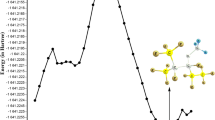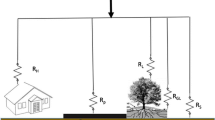Abstract
THE compound 1,1-dichloro-2,2,2-trifluoroethane (CFC-123), which is potentially usable as a foam-blowing agent in the plastics industry, an aerosol propellant and a refrigerant, has been proposed as an industrial substitute for trichlorofluoromethane (CFC-11), the use of which is increasingly restricted because of its effects on the ozone layer and on climate1–3. It is expected that CFC-123, although like CFC-11 an absorber of infrared radiation, will be less stable in the atmosphere because of its expected reaction with OH radicals in the troposphere. Using a three-dimensional global model of the atmosphere, we have calculated the chemical destruction rates of CFC-123 by various processes, confirming that the chief sink is destruction by OH radicals below 12 km, which accounts for 88% of its loss. The calculated destruction rate is greatest in the equatorial region below 2 km. The calculated steady-state lifetime of CFC-123 is 1.5 years, based on the best available estimate of the rate constant of the reaction with OH. This lifetime is very much shorter than that of CFC-11, the destruction of which is largely confined to the stratosphere. For equal rates (by mass) of CFC-123 and CFC-11 emission to the atmosphere, the molar content in the atmosphere and the injection rate of chlorine into the stratosphere are, respectively, 48 and 14 times greater for CFC-11 than for CFC-123 in steady-state.
Similar content being viewed by others
References
1. Rowland, F. & Molina, M. Rev. Geophys. Space Phys. 13,1–35 (1975). 2. Ramanathan, V., Cicerone, R., Singh, H. & Kiehl, J. J. geophys. Res. 90, 5547–5566 (1985). 3. United Nations Environment Programme Montreal Protocol on Substances that Deplete the Ozone Layer: Final Act (United Nations, New York, 1987). 4. Golombek, A. & Prinn, R. J. geophys. Res. 91, 3985–4001 (1986). 5. Golombek, A. & Prinn, R. Geophys. Res. Lett. 16,1153–1156 (1989). 6. DeMore, W. ef al. Chemical Kinetics and Photochemical Data for Use in Stratospheric Modelling, Evaluation No. 9. NASA/JPL Publication (Jet Propulsion Laboratory, Pasadena, in the press). 7. Prinn, R. et al. Science 238, 945–950 (1987). 8. Herman, J. & Mentali, J. J. geophys. Res. 87, 8967–8975 (1982). 9. DeMore, W. et al. Chemical Kinetics and Photochemical Data for Use in Stratospheric Modelling, Evaluation No. 8. NASA/JPL Publication 87–41 (Jet Propulsion Laboratory, Pasadena, 1987). 10. Davidson, J., Schifi, H., Brown, T. & Howard, C. JL chem. Phys. 69, 4277–4279 (1978). 11. Gillotay, D., Simon, P. & Brasseur G. Planetary and Space Science (Pergamon, Oxford, in the press). 12. Atkinson, R. ef al. J. phys. Chem. ©f. Data 18, 881–1081 (1989). 13. Ko, M. & Sze, N. D. Nature 297, 317–319 (1982).
Author information
Authors and Affiliations
Rights and permissions
About this article
Cite this article
Prinn, R., Golombek, A. Global atmospheric chemistry of CFC-123. Nature 344, 47–49 (1990). https://doi.org/10.1038/344047a0
Received:
Accepted:
Issue Date:
DOI: https://doi.org/10.1038/344047a0
- Springer Nature Limited
This article is cited by
-
A global three-dimensional model of the stratospheric sulfuric acid layer
Journal of Atmospheric Chemistry (1993)





